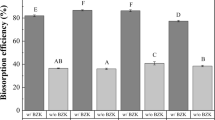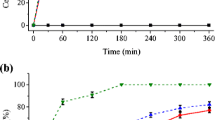Abstract
The release of heavy metals in aquatic systems due to the discharge of industrial wastewaters is a matter of environmental concern. Heat-inactivated cells of a flocculent strain of Saccharomyces cerevisiae were used in the bioremediation, in a batch mode, of a real electroplating effluent containing Cu, Ni, and Cr. In this approach, no previous reduction of Cr(VI) to Cr(III) was required. Cr(VI) was selectively removed (98%) by yeast biomass at pH 2.3. At this pH, Cr(VI) is mainly in the form of HCrO −4 and yeast surface is surrounded by H+ ions, which enhance the Cr(VI) interaction with biomass binding sites by electrostatic forces. Subsequently, pH of the effluent was raised up to 6.0; this pH maximizes the efficiency of cations removal since at this pH the main binding groups of yeast cells are totally or partially deprotonated. The passage of effluent through a series of sequential batches, at pH 6.0, allowed, after the third batch, the removal of Cu(II), Ni (II), Cr total, and Cr(VI) in the effluent to values below the legal limit of discharge. The strategy proposed in the present work can be used in plants for the treatment of heavy metals rich industrial effluents containing simultaneously Cr(VI) and Cr(III).


Similar content being viewed by others
References
American Public Health Association (APHA), et al. (1998). Standard methods for the examination of water and wastewater (20th ed.). Washington, DC: American Public Health Association.
Bingol, A., Ucun, H., Bayhan, Y. K., Karagunduz, A., Cakici, A., & Keskinler, B. (2004). Removal of chromate anions from aqueous stream by a cationic surfactant-modified yeast. Bioresource Technology, 94, 245–249.
Brady, D., & Duncan, J. R. (1994). Bioaccumulation of metal-cations by Saccharomyces cerevisiae. Applied Microbiology and Biotechnology, 41, 149–154.
Cojocaru, C., Diaconu, M., Cretescu, I., Savic, J., & Vasic, V. (2009). Biosorption of copper (II) ions from aqua solutions using dried yeast biomass. Colloids and Surfaces A-Physicochemical and Engineering Aspects, 335, 181–188.
Decreto-lei 236/98 (1998). Anexo XVIII. Valores limite de emissão na descarga de águas residuais. Diário da República, série I-A, 176/98, 3717–3718.
Ferraz, A. I., & Teixeira, J. A. (1999). The use of flocculating brewer’s yeast for Cr(III) and Pb(II) removal from residual wastewaters. Bioprocess Engineering, 21, 431–437.
Gadd, G. M. (2009). Biosorption: critical review of scientific rationale, environmental importance and significance for pollution treatment. Journal of Chemical Technology & Biotechnology, 84, 13–28.
Gomez, V., & Callao, M. P. (2006). Chromium determination and speciation since 2000. TRAC-Trends in Analytical Chemistry, 25, 1006–1015.
Goyal, N., Jain, S. C., & Banerjee, U. C. (2003). Comparative studies on the microbial adsorption of heavy metals. Advances in Environmental Research, 7, 311–319.
Krauter, P., Martinelli, R., Williams, K., & Martins, S. (1996). Removal of Cr(VI) from ground water by Saccharomyces cerevisiae. Biodegradation, 7, 277–286.
Machado, M. D., Santos, M. S. F., Gouveia, C., Soares, H. M. V. M., & Soares, E. V. (2008). Removal of heavy metals using a brewer’s yeast strain of Saccharomyces cerevisiae: the flocculation as a separation process. Bioresource Technology, 99, 2107–2115.
Machado, M. D., Janssens, S., Soares, H. M. V. M., & Soares, E. V. (2009). Removal of heavy metals using a brewer’s yeast strain of Saccharomyces cerevisiae: advantages of using dead biomass. Journal of Applied Microbiology, 106, 1792–1804.
Martell, A. E., & Smith, R. M. (2004). NIST critically selected stability constants of metal complexes database. NIST standard reference database 46 version 8.0. Gaithersburg, MD: US Department of Commerce, National Institute of Standards and Technology.
Mertz, W. (1993). Chromium in human nutrition: a review. Journal of Nutrition, 123, 626–633.
Özer, A., & Özer, D. (2003). Comparative study of the biosorption of Pb(II), Ni(II), and Cr(VI) ions onto S. cerevisiae: determination of biosorption heats. Journal of Hazardous Materials, 100, 219–229.
Parvathi, K., & Nagendran, R. (2007). Biosorption of chromium from effluent generated in chrome-electroplating unit using Saccharomyces cerevisiae. Separation Science and Technology, 42, 625–638.
Pechova, A., & Pavlata, L. (2007). Chromium as an essential nutrient: a review. Veterinarni Medicina, 52, 1–18.
Prigione, V., Zerlottin, M., Refosco, D., Tigini, V., Anastasi, A., & Varese, G. C. (2009). Chromium removal from a real tanning effluent by autochthonous and allochthonous fungi. Bioresource Technology, 100, 2770–2776.
Schecher, W. D., & McAvoy, D. C. (2003). MINEQL+: a chemical equilibrium modeling system, version 4.5 for windows, user’s manual. Hallowell, Maine: Environmental Research Software.
Soares, E. V., DeConinck, G., Duarte, F., & Soares, H. M. V. M. (2002). Use of Saccharomyces cerevisiae for Cu2+ removal from solution: the advantages of using a flocculent strain. Biotechnology Letters, 24, 663–666.
US-EPA. (1984). Guidance manual for electroplating and metal finishing pretreatment standards. EPA-440/1-84/091g. Washington, DC: U.S. Environmental Protection Agency.
Volesky, B. (2001). Detoxification of metal-bearing effluents: biosorption for the next century. Hydrometallurgy, 59, 203–216.
Wang, J., & Chen, C. (2006). Biosorption of heavy metals by Saccharomyces cerevisiae: a review. Biotechnology Advances, 24, 427–451.
Zhao, M., & Duncan, J. R. (1998). Column sorption of Cr(VI) from electroplating effluent using formaldehyde cross-linked Saccharomyces cerevisiae. Biotechnology Letters, 20, 603–606.
Acknowledgments
The authors thank to the “Fundação para a Ciência e a Tecnologia” (FCT) from Portuguese Government for the financial support of this work with FEDER founds, by the Project POCTI/CTA/47875/2002. Manuela D. Machado is also gratefully acknowledged for a grant scholarship financed under the same project and another grant from FCT (SFRH/BD/31755/2006).
Author information
Authors and Affiliations
Corresponding authors
Rights and permissions
About this article
Cite this article
Machado, M.D., Soares, H.M.V.M. & Soares, E.V. Removal of Chromium, Copper, and Nickel from an Electroplating Effluent Using a Flocculent Brewer’s Yeast Strain of Saccharomyces cerevisiae . Water Air Soil Pollut 212, 199–204 (2010). https://doi.org/10.1007/s11270-010-0332-1
Received:
Accepted:
Published:
Issue Date:
DOI: https://doi.org/10.1007/s11270-010-0332-1




